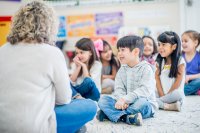Critical Literacy in Early Elementary Grades
Using a form of literary criticism in tandem with drama activities helps young students think deeply about how stories are constructed.
Your content has been saved!
Go to My Saved Content.From the back of her class, I watched as one of my favorite colleagues read to her second-grade students. While reading, she paused, allowed for turn and talks, and asked students to make predictions.
When she had finished reading, my colleague asked questions about the plot, setting, and character traits. In many respects, the lesson was a success—the students had participated eagerly. However, my colleague told me that she wanted more from her read-aloud time. Having seen my students engage in drama-related literacy activities, she was curious about how she could weave those ideas into her literacy lessons, so I shared the nine-day critical literacy and drama framework described below.
What Is Critical literacy?
Although there is no set definition of critical literacy, it essentially involves examining the relationship between language and power in a text. This work is responsive and thoughtful in nature. The chosen text, students’ comfort and familiarity with the text, and the lesson goals all have an effect on what happens in the classroom.
Using the four dimensions of critical literacy—disrupting the commonplace, considering multiple viewpoints, focusing on the sociopolitical, and taking action—as a springboard, I focus on how purposeful questioning, discussion, and improvised drama might influence how students engage with literacy lessons.
Setting the Stage
The first step is selecting a strong mentor text, one with multiple narratives, in which alternate stories are told between the lines and within the illustrations. A worthwhile text should serve to launch counternarratives or conversations about identity and social issues, or about differences in power and privilege. Children should be able to see themselves and learn about the lives of others through the text. Examples include: A Chair for My Mother by Vera Williams, Islandborn by Junot Díaz, Each Kindness by Jacqueline Woodson, The Remember Balloons by Jessie Oliveros, and Another by Christian Robinson.
Here is my nine-day plan for discussing the text Boy by Phil Cummings.
Day 1. Introduce and discuss: First I reveal the cover and ask students to make predictions and share reflections. Then I read the book to the students, pausing for partner discussions. After the reading and discussion, I ask questions such as:
- Whose voice do you notice most in this story? Whose voice is missing?
- What do you think Boy wished the villagers knew about him?
- Can you tell the story of what the villagers thought as Boy approached the battle?
- How did the dragon discover the village? Does the dragon have a family?
- How is your life like or different from Boy’s life? How can we use this story to see our world differently?
Days 2 and 3. Review and set up the drama activities: The intention of drama activities is to draw deeper meaning from a story. The drama offers more than a performance—it’s a way of learning. In each drama activity, students volunteer to become characters from the text.
If the class is focused on giving a voice to an oppressed character or uncovering motive, I may choose to hot seat, meaning that students interview a character. With Boy, my students chose to interview the dragon, Boy, and the townspeople.
Perhaps students want to encourage a character at a pivotal moment. If so, I might carry out a corridor of voices, where students line a hallway and express what was left unsaid in the text. Sometimes, student opinions are clearly divided—in these situations, a town hall meeting allows deliberation on important issues from the book. While exploring Boy, for instance, students participated in a town hall meeting to decide if the dragon should stay in the town.
Finally, when we speculate about a character’s history, I sometimes have students create flashbacks to shed new light on the story, or imagine future scenes to push the focus beyond the end of the book.
Day 4. Shared writing: As a group, we author a piece of writing. I bring in linked texts, model my thinking, and ask for student input. The piece can be a letter to a community member, the author, or a character from the story. It might also take on the form of a journal entry as a character or a part of the story told from an alternate perspective.
Based on the reading, discussion, and drama activities, students discuss the possible writing forms (e.g., poem, letter, comic, diary entry), and participate in peer conferences so they can brainstorm and gain feedback.
Days 5, 6, and 7. Writing: Students need time to create meaningful works. Throughout, they write and then revise their work. I engage in writing conferences with students (one-to-one or small group) to support and nudge each of them.
Days 8 and 9. Sharing their work: Sharing writing and creating action plans are integral to this process. The action plans are student-led and ongoing.
Examples include arranging fundraisers, partnering with community organizations, or engaging in service projects. Over the years, I’ve seen this action take on many forms including, performing skits at senior citizen homes, volunteering to stock shelves at shelters, and supporting local Special Olympics groups. Making space and time to support action plans makes a difference in the type and quality of work students engage in.
Later in the semester, I found myself at the back of my colleague’s classroom again. This time, I watched as she hosted a talk show to interview characters. The student input had come a long way, and when I asked how she felt about the lesson, she said, “Now that I’ve done it this way, I can never go back!”
